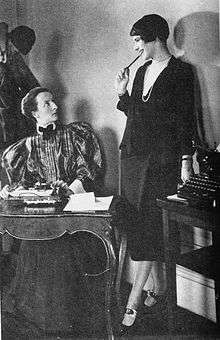Peter Arno
Peter Arno (né Curtis Arnoux Peters, Jr.) (January 8, 1904 – February 22, 1968) was a U.S. cartoonist. He contributed cartoons and 99 covers to The New Yorker from 1925, the magazine's first year, until 1968,[1] the year of his death. In 2015, New Yorker contributor Roger Angell described him as "the magazine's first genius".[2]
Peter Arno | |
|---|---|
.jpg) Arno in 1942 | |
| Born | Curtis Arnoux Peters, Jr. January 8, 1904 New York City, New York |
| Died | February 22, 1968 (aged 64) |
| Nationality | American |
| Education | Yale University Hotchkiss School |
| Occupation | Cartoonist |
| Employer | The New Yorker (1925–1968) |
| Known for | Created 99 covers for The New Yorker |
| Spouse(s) | Lois Long (1927—1931) Mary Livingston Lansing (1935–1939) |
| Children | Patricia Arno |
Biography
Arno was born Curtis Arnoux Peters, Jr. on January 8, 1904, in New York City. His father was Curtis Arnoux Peters, a New York State Supreme Court judge. He was educated at the Hotchkiss School and Yale University, where he contributed illustrations, covers and cartoons to The Yale Record, the campus humor magazine, as "Peters".[3] He also formed a jazz band called the Yale Collegians, in which he played piano, banjo, and accordion.[4] Arno's infatuation with show business later had him designing, writing, and/or producing for four Broadway shows, and appearing with fellow cartoonists in the film Artists and Models.
After one year at Yale he moved home to Manhattan and worked as an illustrator for a silent film company (Chadwick Films) before joining the staff of the fledgling magazine The New Yorker.[5] The iconic cartoons and covers he created there, from 1925 through 1968, helped establish the magazine's reputation for sophisticated humor and fine illustration. His work often depicted a cross-section of New York City society, though he was also inspired by situations he encountered during his travels.[6][7] Arno drew his cartoons in batches, usually over a two-day period each week.[8] Arno often worked with gag writers, one of whom coined the popular expression "back to the drawing board" in a famous March 1, 1941 cartoon.[9][10]

In 1927 he married Lois Long, a popular New Yorker columnist and fashion editor who wrote under the pseudonym "Lipstick." The very embodiment of the glamorous flapper, she also wrote reviews of New York speakeasies. Their one daughter, Patricia, was born September 18, 1928, and the couple divorced in 1930. Arno later married debutante Mary Livingston Lansing in August 1935; they divorced in July 1939.
After his second divorce, Arno moved to a farm near Harrison, New York, where he lived in seclusion, enjoying music, guns, and sports cars.[11]
Arno died of emphysema on February 22, 1968, at the age of 64. He is buried at Kensico Cemetery in Valhalla, New York.
A biography, Peter Arno: The Mad Mad World of The New Yorker's Greatest Cartoonist by New Yorker cartoonist, Michael Maslin was published in April 2016 by Regan Arts.
Bibliography
- Whoops Dearie!. New York: Simon & Schuster, 1927.
- Parade. New York: H. Liveright, 1929.
- Hullabaloo. New York: H. Liveright, 1930.
- Circus. New York: H. Liveright, 1931.
- Favorites. New York: Blue Ribbon Books, 1932.
- For Members Only. New York: Simon & Schuster, 1935.
- Cartoon Revue. New York: Simon & Schuster, 1941.
- Man in the Shower. New York: Simon & Schuster, 1944.
- Sizzling Platter. New York: Simon & Schuster, 1949.
- Ladies and Gentlemen. New York: Simon & Schuster, 1951.
- Hell of a Way to Run a Railroad. New York: Simon & Schuster, 1956.
- Lady in the Shower. New York: Simon & Schuster, 1967.
- Peter Arno. New York: Dodd, Mead, 1979.
References
- Remnick, David, ed. (2005) The Complete New Yorker: Eighty Years of the Nation's Greatest Magazine. New York: Random House.
- Angell, R. "Snaps: 1925–1935". The New Yorker, February 23 & March 2, 2015 (90th Anniversary Issue), p. 20.
- Arno, Peter (as "Peters") (January 17, 1923). Cover Illustration. The Yale Record. New Haven: Yale Record.
- Arno, Peter Robert C. Harvey: http://www.anb.org/articles/16/16-00045.html; American National Biography Online February 2000
- Maslin, Michael. "Peter Arno: The Mad Mad World of The New Yorker's Greatest Cartoonist" New York: Regan Arts, 2016.
- Topliss, Iain. The Comic Worlds of Peter Arno, William Steig, Charles Addams, and Saul Steinberg. Baltimore and London: The Johns Hopkins University Press, 2005.
- Mankoff, Robert, ed. (2004) The Complete Cartoons of the New Yorker. New York: Black Dog & Leventhal Publishers.
- Arno, Peter Robert C. Harvey: http://www.anb.org/articles/16/16-00045.html; American National Biography Online February. 2000
- Arno, Peter (March 1, 1941). Cartoon. The New Yorker. New York: Conde Nast.
- Mankoff, Robert, The Perfect Cartoon: Part Two, New Yorker, June 11, 2014
- Arno, Peter Robert C. Harvey: http://www.anb.org/articles/16/16-00045.html; American National Biography Online February. 2000
A Comics Studies Reader. Jackson: University Press of Mississippi, 2009
External links
- Peter Arno on IMDb
- Peter Arno at the Internet Broadway Database

- Peter Arno at Find a Grave
- Peter Arno on The New Yorker's Cartoon Bank
- Peter Arno, An Appreciation, Searching for Laugh
- The Ohio State University Billy Ireland Cartoon Library & Museum Art Database
- The Double Life of Peter Arno, *The New Yorker’*s Most Influential Cartoonist